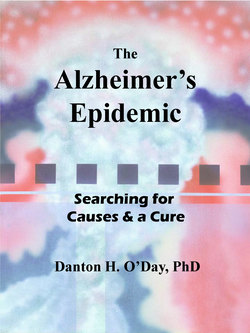Читать книгу The Alzheimer's Epidemic - Danton O'Day - Страница 7
На сайте Литреса книга снята с продажи.
The Alzheimer’s Epidemic
ОглавлениеBefore we begin, we need to get things clear up front. Just what is The Alzheimer’s Epidemic? How can a disease like Alzheimer’s be considered an epidemic? Typically we think of an epidemic as a disease caused by a viral or bacterial infection. However, an epidemic can also be considered to be the widespread occurrence of a disease that greatly surpasses what would normally be expected.
Alzheimer’s disease can be considered an epidemic because it is widespread and continues to spread very rapidly. While it is not caused by a contagious agent, there is one known direct cause of Alzheimer’s disease: that cause is aging. There is an unprecedented growth of elderly populations worldwide. According to the US Centers for Disease Control and Prevention, the World Health Organization and the United Nations, this is due not only to the aging of the current population but also to the decline in fertility that is occurring around the world. Thus people are getting older while fewer children are being born.
Things are going to get a lot worse before they get better and the cost to society could be potentially unsustainable. At best, the cost will drain medical resources of all but those countries with the most robust economies. So there is an unquestionable need not only to find a cure but, in the short term, to find ways to diminish the effects of the disease. This is most evident on the frontlines of the disease: the impact on the individual and their immediate family.
The word “dementia” used to be an alternative term for madness. Today dementia is defined as a significant decline in one’s mental functioning. This intellectual decline can involve problems with thinking, reasoning and memory. Alzheimer’s is the most common form of dementia in that it accounts for between 50–70% of all dementia cases. It is estimated that Alzheimer’s disease affects one in eight people who are over 65 years old. The incidence increases with age so that about 42% of individuals over 85 years old are afflicted with the disease. Already the impact of Alzheimer’s worldwide is staggering—more that 24 million people are suffering from the disease.
The problem is these numbers are increasing with a new case of Alzheimer’s disease occurring every 7 seconds. Based on statistical analyses of our aging populations, it is projected that the number of Alzheimer’s sufferers will double every 20 years. Thus there is no doubt that the disease is on the verge of truly reaching epidemic proportions with devastating implications to societies worldwide. The Alzheimer’s crisis has started and scientists are trying to deal with it. It has been argued that if the onset of Alzheimer’s disease can be delayed by a single year through therapeutic intervention then there would be around nine million fewer cases than expected by 2050!
Thus, with a new case being diagnosed every seven seconds worldwide, Alzheimer’s disease is on the brink of reaching devastating epidemic proportions as the world population ages and more sufferers appear. Is this a stoppable epidemic or one that will drain our personal and societal resources both emotionally and financially? At present, with no cure on the horizon, the epidemic seems all the more daunting.
To add to this concern, at present there are no drugs that can stop the progression of the disease. Those that are available can alleviate the symptoms of Alzheimer’s but only for a limited time. Why is this? It is because no one truly understands what causes the disease. While many of the symptoms and the phases of progression of the disease are known, what precipitates Alzheimer’s disease remains a mystery. As we will see, even the suspects that are believed to cause the neurological degeneration that occurs in Alzheimer’s disease in fact may not be the initial cause of the disease. Will we end up spending billions of dollars investigating the wrong culprits?
This book is not designed to offer false hope. It is designed to offer realistic hope—and there is hope. This volume aims to give hope by explaining what we do know about the onset, development and progression of Alzheimer’s disease. It will reveal the primary targets of research and exactly what is being done to knock out those targets. It will provide hope by showing that all of the past research has not been in vain—it has set the stage for a successful future. Inroads are being made into this complex and, as yet, poorly understood disease. Hope lies on the horizon—just how far away that horizon is remains to be determined. This chapter will provide an overview of subjects and issues that subsequent chapters will deal with in detail. So let’s begin with a look at what the disease is and what are believed to be the primary causes.
